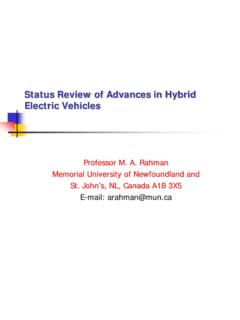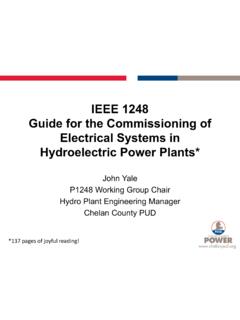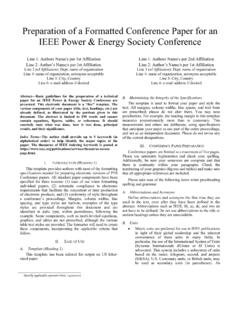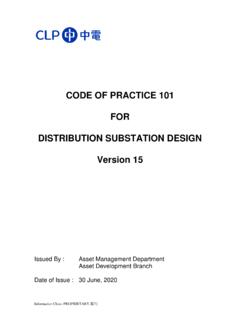Transcription of Solar Power Plant Design and Interconnection
1 Solar Power Plant Design and InterconnectionS&C Electric Camm, WilliamsWind & Solar Super SessionJuly 27, 2011 Introduction Utility-scale PV Power Plant Grounding Reactive Power and Voltage Control Low Voltage Ride-Through and System Stability Short-Circuit Contributions Utility-scale CSP Power plantOutlineIntroduction SolarPowerDevelopmentintheUS Photovoltaic(PV)powerplants Steadygrowthinresidential,commercialPVin stallations Utility-scaleinstallationsemergingin2008 0200400600800100012001400200020012002200 3200420052006200720082009 Capacity (MW)PV PlantsAnnual Capacity AdditionsCumulative CapacityIntroduction Concentratingsolarpower(CSP)powerplants 9 CSPplantstotaling354 MWconstructedfrom1984to1990 60 MWSolarOneplantinstalledinNevadain2007 NewCSPtechnologydevelopmentsin2010:dishS tirlingsystemsIntroduction Most recent developments include large utility-scale PV plants 80 MW Sarnia Plant in Ontario, Canada 3 Large projects in CA just received conditional loan guaranteesIntroduction Large utility-scale PV Plant developments are driving changes in inverter Design Distributed generation (DG) applications.
2 No reactive Power capability for voltage control fast disconnection from the utility system in the event of a disturbance anti-islanding protection Rules for large transmission-connect plants require this performance and are leading to changes in PV Plant Design practicesTo Collector SystemDC -DC + 3 ~Inverter ControlDC Voltage MonitoringEMC FilterFilter 3 ~from PV arrays Module 1 Module 2from PV arraysEMC FilterEMC FilterEMC FilterFilterTo other modulesUtility-Scale PV Power Plant Design Design issues Grounding Reactive Power and voltage control Low voltage ride-through and system stability Short-circuit contributionsUtility-Scale PV Power Plant Utility-Scale PV Power Plant Grounding Grounding in LV system in accordance with the applicable articles of NEC PV array grounding at a single point Equipment grounding Grounding on the MV system in accordance with applicable NEC and NESC requirementsUtility-Scale PV Power Plant Requirements for grounding transformers on the MV feeders dependent on inverter Design IEEE Std1547/UL 1741 compliant inverters.
3 No need for a grounding transformer or other means of feeder grounding once the feeder is isolated Changes in inverter designs will require grounding transformer or other means of feeder grounding to limit temporary overvoltages on the feeder to within acceptable levelsUtility-Scale PV Power Plant Reactive Power and voltage control IEEE Std1547/UL 1741 compliant inverters will typically not have reactive Power capability & operate with a unity Power factor To meet transmission Interconnection requirements for reactive Power and voltage control, substation-based reactive Power compensation systems (RCS) will typically be appliedUtility-Scale PV Power Plant RCS typically consist of a STATCOM with dynamic reactive Power capability and switched capacitor and reactor banksUtility-Scale PV Power Plant Low Voltage Ride-Through (LVRT)
4 And System Stability PV plants using inverters that are IEEE Std1547/UL 1741 compliant do not have LVRT Large penetration levels of PV plants using these types of inverters at distribution voltage level can affect the grid stability New inverter designs with reactive Power and LVRT capability and other grid friendly features are expected to be required in new Plant designsUtility-Scale PV Power Plant Short-Circuit Contributions PV plants using inverters that are IEEE Std1547/UL 1741 compliant contribute fault current for a few cycles A fault on the line will typically trigger an instantaneous AC undervoltage trip of the inverter Inverter gating will stop immediately, followed by the opening of the AC contactor after a few cycles New inverter Design expected to have short-circuit contribution limited by the inverter apparent Power (kVA) rating and similar to that of a Type 4 (full converter)
5 Type wind turbine generatorUtility-Scale CSP Plant Utility-scale CSP Power plants have been predominantly Solar thermal plants using parabolic trough technology Since these plants use conventional synchronous generators with or without thermal energy storage electrical characteristics of the Plant does not differ appreciable from that of a conventional Power Plant Development of newer technologies in CSP plants, particularly dish Stirling systems, is creating new challenges in the Design of the low-and medium-voltage collector systems for large Solar Power plantsUtility-Scale CSP Plant New dish Stirling systems use 10 to 25 kW Solar concentrator in a dish structure Mirrors collect and concentrate Solar energy into a Power conversion unit Includes a reciprocating Stirling engine The Sterling engine uses an internal working fluid, typically hydrogen or helium Utility-Scale CSP Plant Stirling engine drives a squirrel-cage induction generator Multiple 10 to 25 kW units are connected at low voltage into groups & connected to a step-up transformer The thermal, electrical, and control systems of the dish-Stirling system.
6 Along with a method for simulation are presented in "Modeling of Dish-Stirling Solar Thermal Power Generation" by Dustin Howard and Ronald G. Harley, in Proc. 2010 IEEE Power & Energy Society General Meeting, Minneapols, Minnesota, USA, July 25-29, 2010 Utility-Scale CSP Plant Reactive Power and voltage control requirements of new dish Stirling CSP Plant : STATCOM and switched capacitors Induction generators and Stirling engines in dish Stirling systems have minimal rotational inertia Need for additional internal speed control measures to avoid overspeedingduring a grid fault Speed-control measures allow the units to ride through up to a few seconds of grid or in- Plant faults prior to eventual disconnectionUtility-Scale CSP Plant The induction generators in dish Stirling systems will respond similarly to small induction machines to contribute to faults Peak fault current contribution will be approximately 5 to 6 per unit Decaying to nominal current in less than 6 cyclesUtility-Scale CSP Plant Rapid Power fluctuations in dish Stirling system plants will be mitigated by the thermal inertia of the Stirling engine The composite effect of a
7 Large number of units will also mitigate Power ramp rates During Plant start-up, a large number of units must be brought on-line in a relatively short time period to maximize Plant productivity Start-up sequences must be controlled to limit the Power ramp rates to within specified limits






